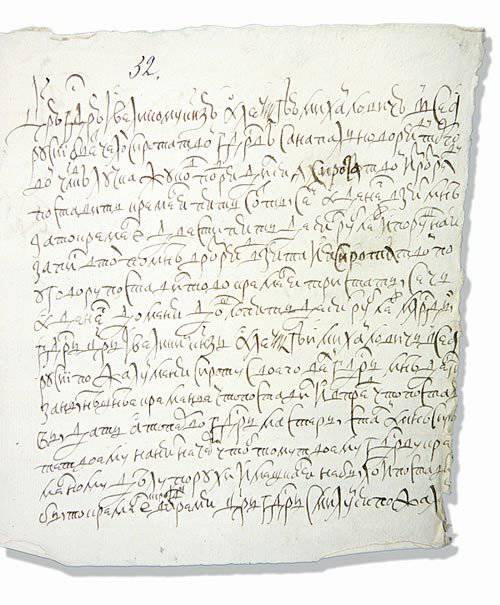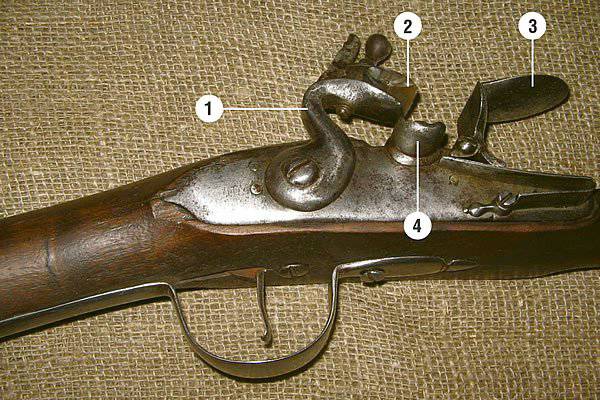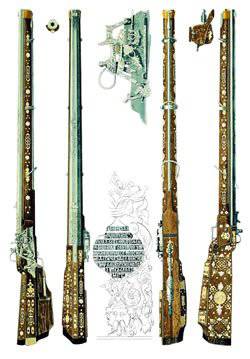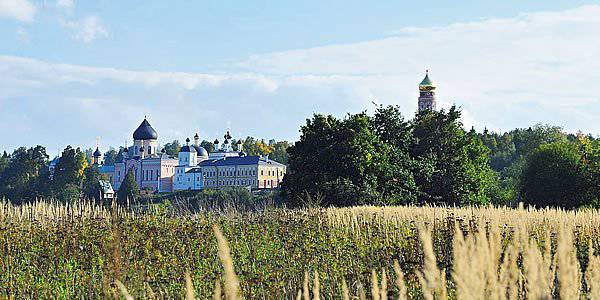State defense order in the XVII century

In Russia, the supply of the army weapons always been under strict control of the country's leadership
The study of materials of the Russian State Archive of Ancient Acts (RGADA) made it possible to open another little-known but very interesting page. stories Lopasnensky region (now Chekhov district, Moscow region). It turns out that in the middle of the 17th century, the land around the Ascension Monastery of David’s Deserts was a kind of “special area” where, according to the royal command, large-scale mining of strategically important raw materials was established - “good food flour”, without which it was impossible to equip the Russian army with the latest firearms.
In 1645, 16-year-old Tsar and Grand Prince of All Russia Alexei Mikhailovich Romanov, the future father of the first Russian emperor Peter the Great, ascended the throne. This was the time when Russia continued to rise after the disaster of the Time of Troubles, restored its strength, prepared for the struggle for the lands lost during the Polish and Swedish intervention. First of all, it was about Smolensk, Chernihiv, Novgorod-Seversky, the whole of Left-Bank Ukraine, Kiev, under the authority of the Commonwealth. Even then, the task was to return the Russian positions in the Baltic States and access to the Baltic Sea. In addition, the further expansion of the possessions of Moscow Russia in the south, in the endless Zaoksky Dick Pole, also required serious military efforts.
In a word, in the foreseeable decades there was a stubborn and protracted political and armed struggle between Russia and very strong opponents — Poland, Sweden and the Crimean Khanate, behind which stood the Ottoman Empire.

Draft decree Alexei Mikhailovich mining flint on Lopasna.
With this in mind, a fundamental reform of the entire system of the armed forces began and was in full swing. In 30-70 XVII century, the total number of marching troops increased 5-6 times. And if by 1651 the total number of military people reached 133 thousand people, then at the end of 70-ies the king could immediately send 200 thousandth troops to the march.
But the main thing was the beginning of the creation of the Russian regular army, the formation of well-trained and armed "regiments of the new system." These regiments became the basis of regular troops, for which, for the first time in 1647 during the reign of Tsar Alexei Mikhailovich, the military charter “The Teachings and Cunning of the Military System” was compiled for the first time.
Thus, contrary to established opinion, the national regular army in Russia appeared earlier than in many countries of Western Europe.
A key problem was equipping the army with the latest firearms.
It must be said that the first half of the seventeenth century was a time when, as in the whole of Europe, a radical technical re-equipment of the army was going on in the Russian state. The most effective weapons of that time were rifles with flint spark locks, which replaced the outdated, unreliable and inconvenient wick firearms.
In Russia, handguns with flint locks (wheeled or percussion) were called “samopalami” or “chills”. The first written mention of them dates back to the times of Ivan the Terrible, the 80 years of the XVI century. Then, basically, they were brought to us from abroad. But already in the first decades of the XVII century, samopaly and food with flint locks began to be mass produced and Russian masters. In Moscow, their products were sold by wholesalers and retailers by merchants of the Samopalny or Pishchalny row.

The sighting range of smooth-bore flint squeezed out was 100-150 m, and the killing power of the bullet reached 200 m. Compared to the outdated wick weapon, you could make up flint rifles and pistols per minute to 3 and even with hard training, to 5 shots per minute . For those times it was a fantastic rate of fire, which gave an undeniable advantage in battle.
All the military people of the "regiments of the new system" (soldiers, dragoons, hussars, reiters, etc.) received a fairly uniform flintlock weapon from the treasury. The introduction of just such a “high-tech” weapon significantly increased the combat capability of the Russian army.
Making weapons and equipping the army with them has always been the most important “sovereign affair”. That is why the extraction and special processing of flint, without which the latest shock and spark weapons of the Russian army could not then have fired, were under the strict control of the state military department, the Bit Order. And if necessary, the problems were resolved personal royal decrees.
 They squeaked for Tsar Alexei Mikhailovich by Moscow masters.
They squeaked for Tsar Alexei Mikhailovich by Moscow masters.Judging by the archival documents found, in the middle course of the Lopasni in the 17th century, quite a lot of stone raw materials were found that meet the highest requirements for weapon flints. On the grounds of the palace Khatunsky volost and the monastery of David's desert, their active prey immediately began, which was entrusted to “the merchant of the Pischelny Ryad Luchka (Luka — author's note) Zhukov”: “... According to the sovereign Tsarev and Grand Duke Alexei Mikhailovich of All Russia, decree The foodstuff row, the salesman Luchka Zhukov ... He went to the Khatunsky volost to the village of Bovykinu and to the Dovydova desert on the Lopasne river so that in the current year in 7158 (1649 - auth.) October in 11 he got it, Luchka , in the Retail to put pishch There are five hundred thousand good seals ... "
Half a million gunsmiths is a serious scale. They could equip firearms of more than one thousand warriors.
The urgency and importance of the unconditional execution of the 17th century state defense order, as well as the strict ban on unauthorized mining of the fiery stone: “... And according to the sovereign Tsarev and Grand Duke Alexei Mikhailovich of All Russia, the decree ... , so that to him, by the agreement of the sovereign's treasury, to make it to the term of the treasury without any tinkering (delays - note auth.). And according to the sovereign's decree to oprich evo, Luchki, along the river along Lopasna ... it is not ordered to break any people, while he, Luchka, is ordered to put treasures to the state treasury. And if he does not know evo, Luchki, he will learn to dig along the river Lopasne on the shores of the kremenya - and for those people, according to the sovereign's order, they have to pay a large monetary penalty. ”
The scale of the flint mining that had unfolded was probably so large that it displeased the monks of the Davidian Desert, who complained to Tsar Alexei Mikhailovich that the peasants had dug holes even in the fields and at the same time spoiled their crops. In turn, Luka Zhukov also “beat his brow” to the sovereign on Hegumen David of the desert, who opposed the fulfillment of the royal will to extract flint: “... The merciful sovereign Tsar and Grand Duke Alexei Mikhailovich of All Russia, perhaps, his orphan, led the sovereign about flint on the strong to give my sovereign a certificate, so that, sir, in your sovereign's treasury there was no guarantee in that order ... ”
The archive preserved the royal decree of November 7158 (1649), unequivocally indicating that in resolving this conflict, priority was given to the interests of the defense department: "... From the Tsar and Grand Duke Alexei Mikhailovich All Russia Dovidovy Desert Hegumen ... And beat us Luchka Zhukov, what he does in the Khatunsky volost in the village of Bovykin are hired people doing flint, and in the Dovidovye desert in the forest in the ravine, where they used to do this flint, they didn’t give him that flint ... And as you our letter will come to you and persuader Luchka Zhukova in Dovydovy p The mouth of the mouth, where the crap was made in the ravine and where the guide was, ordered me to do it without any treadmill, so that there was no tugging for that matter. ”

Apparently, in a row 1649, Mr. Luka Zhukov was completed in full and on time, and the weapon flint turned out to be of very high quality, “good”. Therefore, already in June of the following 1650, an even larger government order followed the royal decree — already on 900 thousand (!) Gun flints: “... A merchant man, Luchka Zhukov, in the sovereign palace in the Khatunsky volost and in monastic fiefdoms, where there is redwood along the river It is dangerous to make nine hundred thousand people voluntarily rented by people of food stuffing… ”
This time, the control over the strict execution of the “state defense order” was entrusted to Prince Alexei Lvov, who then headed the order of the Grand Palace, in charge of all the royal patrimonies: “... Is the order of the Grand Palace to send the sovereign to the Khatunsky volost to the priest and to the monastic lands to the authorities, to order in the Khatunsky volost and monastic estates along the river Lopasne, where there are flint, to persuade Luchka Zhukov to do hired labor ... ”.
It is known that the peasants of Bavykin, Old Spas, Barantsev, Popov and other villages of the present Chekhov district and later, for almost two centuries, until the middle of the XIX century, mined flint in the vicinity of the Voznesenskaya David desert, and supplied it for "the needs of the troops." So in all the major battles - from Poltava to Borodin - soldiers, officers and generals of the Russian army were gripping a formidable weapon that destroyed the enemy with the help of “good flint”, obtained by the peasants on the banks of the quiet and bright river near Moscow Loprosni.
Information